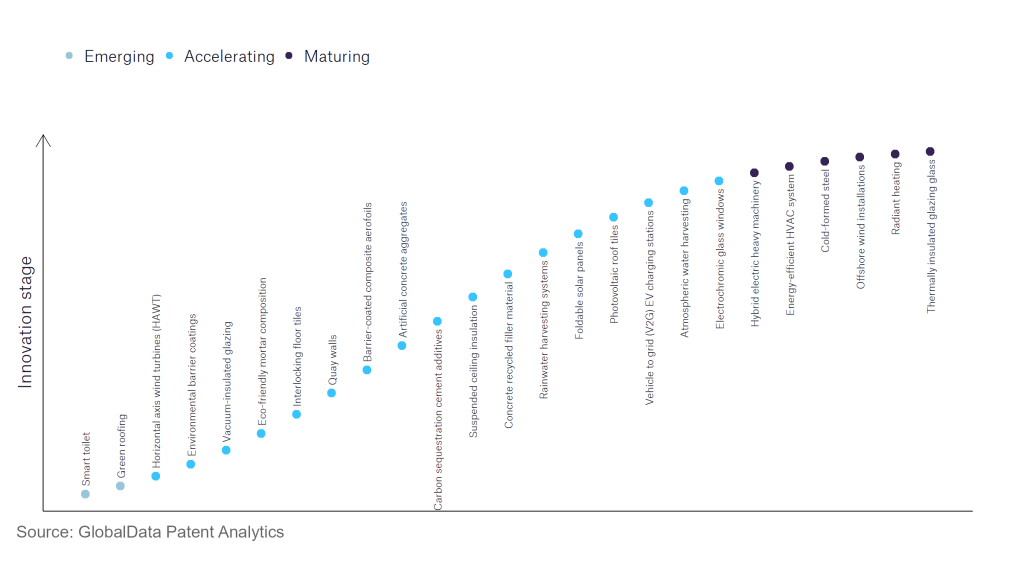The construction industry continues to be a hotbed of innovation, with activity driven by an increased focus on environmental sustainability and workplace safety, and the growing importance of technologies such as the Internet of Things (IoT) and robotics. In the last three years alone, there have been over 248,000 patents filed and granted in the construction industry, according to GlobalData’s report on Environmental sustainability in Construction: Concrete recycled filler material. Buy the report here.
However, not all innovations are equal and nor do they follow a constant upward trend. Instead, their evolution takes the form of an S-shaped curve that reflects their typical lifecycle from early emergence to accelerating adoption, before finally stabilising and reaching maturity.
Identifying where a particular innovation is on this journey, especially those that are in the emerging and accelerating stages, is essential for understanding their current level of adoption and the likely future trajectory and impact they will have.
80+ innovations will shape the construction industry
According to GlobalData’s Technology Foresights, which plots the S-curve for the construction industry using innovation intensity models built on over 179,000 patents, there are 80+ innovation areas that will shape the future of the industry.
Within the emerging innovation stage, smart toilets and green roofing are disruptive technologies that are in the early stages of application and should be tracked closely. HAWT wind turbines, environmental barrier coatings, and vacuum-insulated glazing are some of the accelerating innovation areas, where adoption has been steadily increasing. Among maturing innovation areas are hybrid electric heavy machinery and energy-efficient HVAC system, which are now well established in the industry.
Innovation S-curve for environmental sustainability in the construction industry

Concrete recycled filler material is a key innovation area in environmental sustainability
With the increased focus on sustainable materials and practices in the construction industry, materials manufacturers are seeking ways to reduce carbon-intense polluting materials. Given that the worldwide cement industry is responsible for between 4% and 8% of global CO2 emissions, a key area of innovation has been in developing replacements for primary raw materials in the production of cement and concrete. Recycled filler materials that are processed from waste are being increasingly used.
GlobalData’s analysis also uncovers the companies at the forefront of each innovation area and assesses the potential reach and impact of their patenting activity across different applications and geographies. According to GlobalData, there are 20+ companies, spanning technology vendors, established construction companies, and up-and-coming start-ups engaged in the development and application of concrete recycled filler material.
Key players in concrete recycled filler material – a disruptive innovation in the construction industry
‘Application diversity’ measures the number of different applications identified for each relevant patent and broadly splits companies into either ‘niche’ or ‘diversified’ innovators.
‘Geographic reach’ refers to the number of different countries each relevant patent is registered in and reflects the breadth of geographic application intended, ranging from ‘global’ to ‘local’.
Patent volumes related to concrete recycled filler material
| Company | Total patents (2021 - 2023) | Premium intelligence on the world's largest companies |
| Halliburton | 43 | Unlock Company Profile |
| Holcim | 36 | Unlock Company Profile |
| Sumitomo Osaka Cement | 36 | Unlock Company Profile |
| Omya International | 29 | Unlock Company Profile |
| Yara International | 21 | Unlock Company Profile |
| Active Minerals International | 20 | Unlock Company Profile |
| Ruredil | 18 | Unlock Company Profile |
| James Hardie Industries | 17 | Unlock Company Profile |
| GCP Applied Technologies | 17 | Unlock Company Profile |
| Gebr Knauf | 15 | Unlock Company Profile |
| POSCO Holdings | 11 | Unlock Company Profile |
| Dow | 11 | Unlock Company Profile |
| BASF | 10 | Unlock Company Profile |
| Tauw | 10 | Unlock Company Profile |
| Boral | 9 | Unlock Company Profile |
| Taiheiyo Cement | 9 | Unlock Company Profile |
| CEMEX SAB de CV | 9 | Unlock Company Profile |
| Vulcan Materials | 8 | Unlock Company Profile |
| HeidelbergCement | 7 | Unlock Company Profile |
| TransferTech Sherbrooke (formerly SOCPRA sciences et genie S.E.C.) | 7 | Unlock Company Profile |
| Taisei | 5 | Unlock Company Profile |
Source: GlobalData Patent Analytics
Holcim is among the leading filers of concrete recycled filler materials. The company reported that it recycled 54 million tonnes of materials in 2021, and, in June 2022, it reported that it had produced the world’s first clinker made entirely of recycled minerals. It used recycled materials, ranging from wood ash to waste from mineral processing, in the production of the clinker. Sumitomo Osaka Cement is also a leading filer. In 2021, the company became eligible for the Development Bank of Japan’s Environmental Rating loan programme owing to its business strategy targeting the promotion of energy saving, waste recycling and greenhouse emission reduction. Some other key patent filers in the concrete recycled filler materials industry include Halliburton and Omya International.
In terms of application diversity, James Hardy is among the leaders in the pack, along with Tauw. By means of geographic reach, Active Minerals International held the top position, followed by Yara International.
To further understand the key themes and technologies disrupting the construction industry, access GlobalData’s latest thematic research reports on Construction.
Data Insights
From

The gold standard of business intelligence.
Blending expert knowledge with cutting-edge technology, GlobalData’s unrivalled proprietary data will enable you to decode what’s happening in your market. You can make better informed decisions and gain a future-proof advantage over your competitors.



